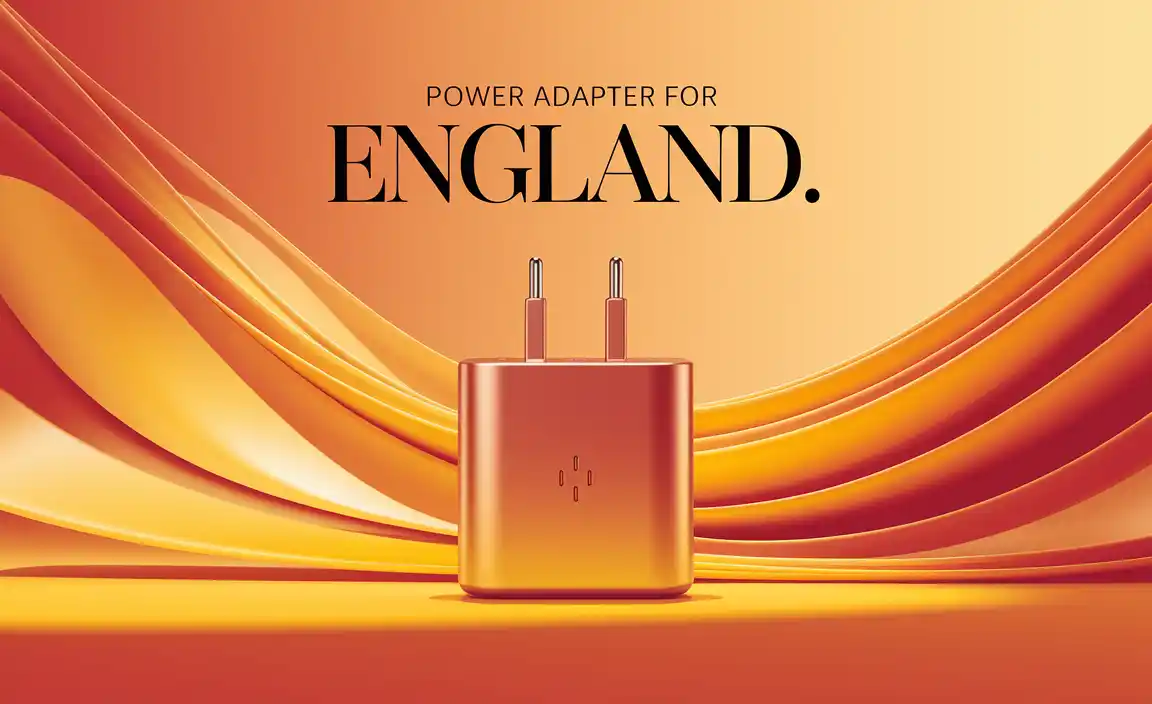Quick Summary: Keep your lithium car battery ready for summer adventures! This guide explains how to safely charge and maintain it for peak performance, ensuring you don’t get stranded in the heat. Follow our simple steps for worry-free driving.
Charging Your Lithium Car Battery for Summer: An Essential Guide
Summer is here, and adventures await! But before you hit the road, is your car’s lithium battery ready for the heat? A dead battery can ruin your plans, leaving you stuck when you least expect it. Don’t let that happen!
Many drivers worry about car batteries, especially with newer lithium technology. It might seem complicated, but understanding how to keep your battery charged and healthy for summer is simpler than you think. This guide is here to help, breaking down everything you need to know in easy steps.
We’ll cover why summer is tough on batteries, how to check your battery’s health, the right way to charge it, and simple tips to keep it going strong all season long. Let’s get your car powered up and ready for sunshine!
Why Summer is a Challenge for Your Car Battery
You might think extreme cold is the worst for car batteries, but high summer heat can be just as damaging, if not more so. Batteries are complex, and temperature plays a huge role in how they perform and how long they last.
High temperatures can speed up the chemical reactions inside a battery, but not in a good way. This can lead to faster degradation, meaning components break down quicker. Think of it like leaving food out in the sun – it spoils faster.
This acceleration can cause:
- Internal Corrosion: Heat increases the rate at which battery components can corrode.
- Reduced Electrolyte: In some battery types (though less common in modern lithium ones), heat can cause the electrolyte fluid to evaporate, reducing its effectiveness.
- Strain on Charging Systems: When it’s hot, your car’s engine often works harder to power accessories like the air conditioning. This puts more demand on the alternator, which charges the battery. If the battery is already stressed by the heat, this can be a double whammy.
- Faster Self-Discharge: Batteries naturally lose charge over time. Heat makes this self-discharge happen even faster, meaning a battery left sitting for a while might be significantly depleted when you need it.
Understanding Your Car’s Lithium Battery
Most modern cars are moving towards lithium-ion (Li-ion) or similar advanced battery chemistries, often referred to collectively as lithium car batteries. These are different from the older lead-acid batteries you might be familiar with from older cars. They offer several advantages, like being lighter and holding a charge better, but they have their own specific needs.
The biggest difference is how they store and release energy. Lithium batteries use lithium ions moving between electrodes. This process is very efficient, but it’s also sensitive to extreme temperatures and overcharging.
Key points to remember about lithium car batteries:
- Advanced Technology: They are designed for better energy density and faster charging compared to lead-acid.
- Battery Management System (BMS): Lithium batteries almost always come with a BMS. This is a crucial electronic system that monitors and controls the battery’s charge, discharge, and temperature. It protects the battery from overcharging, over-discharging, and overheating.
- Sensitivity to Heat: While they perform well in a wider range of temperatures than lead-acid, extreme heat can still stress the BMS and shorten the battery’s lifespan if not managed properly.
- Specialized Charging: They require specific charging profiles that are managed by the BMS and the charger itself. You can’t just hook up any old charger.
Because of the BMS, you generally don’t need to “trickle charge” a lithium car battery like you might have with older types. The BMS handles much of the protection. However, ensuring the battery is charged correctly, especially before periods of high demand or extreme weather, is still important.
When Does Your Car Battery Need Charging?
Several signs suggest your car battery might need a boost, especially as summer approaches. Paying attention to these can prevent a breakdown.
Common Warning Signs:
- Slow Engine Crank: When you turn the key, if the engine sounds sluggish or slow to start, it’s a classic sign the battery isn’t holding a full charge. This is your battery telling you it’s working harder than it should be.
- Dimming Lights: Notice your headlights or interior lights flickering or seeming dimmer than usual, particularly when the engine is off or at idle? That indicates a weak power source.
- Electrical Issues: Power windows operating slower, the radio behaving strangely, or dashboard warning lights flickering can sometimes point to an undercharged battery.
- Battery Warning Light: This is an obvious one. If the battery-shaped warning light comes on your dashboard, it’s time to investigate. It could mean a charging system issue or a failing battery.
- Age of the Battery: Most car batteries, regardless of type, have a lifespan of 3-5 years. If yours is approaching this age, it’s wise to check its health proactively, especially before summer travel. A quick search for “.gov battery lifespan” can offer insights from automotive research sites.
- Infrequent Driving: If your car sits idle for long stretches, especially in hot weather, the battery’s charge can deplete naturally.
Essential Tools for Charging Your Car Battery
You don’t need to be a mechanic to charge your car battery, but having the right tools makes the job safe and efficient. For lithium car batteries, using the correct charger is paramount.
What You’ll Need:
- A Compatible Lithium Battery Charger: This is the most important item. It MUST be designed specifically for your car’s lithium battery type (e.g., LiFePO4, NMC). Using the wrong charger can damage the battery or its BMS. Look for chargers from reputable brands used in automotive forums or recommended by your car manufacturer. This is not the same as a phone charger or a generic battery maintainer.
- (Optional) Battery Terminal Cleaner Brush: A wire brush specifically designed for cleaning battery terminals can ensure a good connection between the charger clamps and your battery terminals.
- (Optional) Gloves and Eye Protection: While lithium batteries are generally safer than lead-acid, it’s always good practice to wear gloves and eye protection when working with electrical systems.
- (Optional) Multimeter: A simple multimeter can help you check the battery’s voltage before and after charging to see the effect. You can find basic digital multimeters online or at hardware stores.
Important Note: Always refer to your car’s owner’s manual and the battery manufacturer’s specifications. They will tell you the exact type of battery your car uses and any specific charging instructions.
How to Safely Charge Your Lithium Car Battery: A Step-by-Step Guide
Charging a lithium car battery is straightforward if you use the correct equipment and follow a few safety steps. The onboard Battery Management System (BMS) does most of the heavy lifting, protecting the battery.
Step-by-Step Instructions:
- Park Safely: Park your car on a level surface in a well-ventilated area, away from flammable materials. Turn off the engine and remove the keys from the ignition. Open your car’s hood.
- Locate the Battery: Your car’s lithium battery might be in the traditional engine bay or elsewhere in the vehicle (like under a seat or in the trunk). Consult your owner’s manual if you’re unsure.
- Identify Terminals: You’ll see two terminals, usually labeled positive (+) and negative (-). The positive terminal often has a red cap or is marked with a ‘+’. The negative terminal is usually black or marked with a ‘-‘.
- Clean Terminals (If Needed): If the terminals look dirty or corroded, use the battery terminal brush to gently clean them. This ensures a good, solid connection for charging. Wipe away any debris.
- Connect the Charger – Positive First: Take the red clamp (+) from your lithium battery charger and connect it firmly to the positive (+) terminal of the car battery. Ensure a secure grip.
- Connect the Charger – Negative Second: Take the black clamp (-) from the charger and connect it firmly to the negative (-) terminal of the car battery.
- Double-Check Connections: Make sure both clamps are securely attached and not touching any metal parts of the car other than the battery terminals. Ensure the charger is not in contact with hot engine parts.
- Plug In and Select Mode: Plug the charger into a grounded electrical outlet. If your charger has different modes (e.g., ‘Lithium’, ‘AGM’, ‘Standard’), make sure you select the correct mode for your lithium battery. Your charger’s manual will guide you through this.
- Monitor the Charging Process: Most modern chargers will have indicator lights or a display showing the charging status. The BMS will manage the charging rate. You can often leave the charger connected for a few to several hours, depending on how depleted the battery is and the charger’s capacity. Some chargers are designed to be left connected as maintainers.
- Complete Charging: The charger will usually indicate when charging is complete (e.g., a green light, reaching a certain voltage). The BMS protects against overcharging, but it’s good practice to disconnect once fully charged, especially before very hot days if you plan to use the car extensively.
- Disconnect the Charger: Unplug the charger from the electrical outlet first. Then, carefully remove the black (-) clamp from the negative battery terminal, followed by the red (+) clamp from the positive terminal.
- Secure Everything: Close the hood. You can now start your car.
Safety First: Never connect the positive clamp to the negative terminal or vice-versa. Always disconnect the negative clamp first when removing and connect it last when attaching to avoid sparks. Refer to resources like the Department of Energy’s vehicle battery recycling page for broader battery insights, although direct charging instructions might vary by specific technology.
Maintaining Your Lithium Car Battery for Summer Longevity
Charging is crucial, but a little ongoing maintenance can significantly extend your lithium car battery’s life and ensure it’s ready for anything summer throws at it.
Regular Checks and Best Practices:
- Monitor Battery Health: If you drive infrequently, consider using a battery monitor or a multimeter periodically. A healthy lithium car battery should typically hold a voltage above 12.8V when fully charged and at rest. For specific lithium chemistries like LiFePO4, voltages might differ slightly – check your battery’s datasheet.
- Avoid Deep Discharges: While the BMS protects the battery, repeatedly draining it close to empty puts more stress on it. Try to avoid leaving accessories like lights or radios on with the engine off for extended periods.
- Temperature Management: This is key for summer. Park in the shade when possible. If your car is in direct sunlight for long periods, the battery can get very hot. While the BMS has thermal protection, consistent high heat accelerates wear.
- Smart Charging Habits: If you have a smart charger designed for lithium batteries, using it periodically (e.g., once a month or before a long trip) can keep the battery topped up and healthy, especially if the car is often used for short trips that don’t fully recharge the battery.
- Check for Loose Connections: Periodically (and safely, with the engine off), visually inspect the battery terminals. Ensure they are clean and that the cables are tight.
- Use the Right Accessories: Be mindful of accessories that draw power when the car is off. Features like dashcams or constant phone charging ports can drain the battery faster, especially when combined with hot weather.
- Consider a Battery Blanket (for extreme heat): While less common for lithium than lead-acid, in extremely hot climates, some advanced battery systems might benefit from insulation to buffer against external temperature spikes. However, always consult your car manufacturer’s recommendations for this.
Lithium vs. Lead-Acid Car Batteries for Summer
It’s helpful to understand how lithium car batteries compare to the older, more traditional lead-acid batteries, especially when it comes to summer performance.
| Feature | Lithium Car Battery | Lead-Acid Car Battery |
|---|---|---|
| Summer Heat Performance | Generally more resilient to heat if managed by BMS, but extreme, constant heat can still accelerate degradation. | Very susceptible to heat, which can lead to faster evaporation of electrolyte (in serviceable types) and internal damage, significantly shortening lifespan. |
| Weight | Significantly lighter. | Much heavier. |
| Lifespan | Often longer, with more charge cycles. | Shorter lifespan, fewer charge cycles. |
| Charging Efficiency | High efficiency, less energy wasted as heat during charging. | Lower efficiency, more energy lost as heat. |
| Cost | Higher upfront cost. | Lower upfront cost. |
| Maintenance | Virtually maintenance-free with BMS. | May require checking electrolyte levels (for non-sealed types) and terminal cleaning. |
| Charging Needs | Requires specific lithium chargers and BMS for safety. Cannot be overcharged easily due to BMS. | More forgiving with chargers, but can be damaged by overcharging or deep discharge if not managed. |
For summer driving, a well-maintained lithium battery, with its sophisticated BMS, is generally a more reliable choice. It’s designed to handle a wider operational range, but understanding its specific needs for charging and heat management is still key.
Troubleshooting Common Battery Issues in Summer
Even with the best care, you might encounter a few common battery hiccups, especially during hot weather. Here’s how to tackle them.
Problem: Car Won’t Start, Engine Cranks Slowly
- Cause: Battery is low on charge or starting to fail. Heat can worsen existing weaknesses.
- Solution:
- Try charging the battery using a compatible lithium charger as described in the steps above.
- If charging doesn’t help or the problem returns quickly, the battery may need replacement.
- If your car has a Jump Start feature and you have another vehicle, you can attempt a jump-start, following proper safety procedures for lithium batteries (often similar to lead-acid but with extra caution around potential BMS issues). Consult your manual or a professional.
Problem: Battery Warning Light is On
- Cause: This light indicates an issue with the charging system or the battery itself. It’s not always the battery, it could be the alternator or a loose connection.
- Solution:
- Check battery terminal connections for tightness and corrosion.
- If connections are good, get the battery and charging system tested immediately by a professional mechanic. Don’t wait, as a failing charging system can leave you stranded.
Problem: Battery Feels Extremely Hot to the Touch
- Cause: Excessive heat, either from ambient temperature or strenuous use (like prolonged idling with AC on full blast in scorching heat).
- Solution:
- If it’s extremely hot from parking in the sun, let the car cool down in a shaded area.
- If the heat is from driving, it might indicate the charging system is working overtime. Less common with lithium batteries due to BMS, but still possible.
- If constantly hot or you suspect a charging issue, have it inspected by a mechanic.
For any persistent or concerning issues, it’s always best to consult a qualified mechanic. They have the tools and expertise to diagnose complex battery and charging system problems accurately. Resources like <a href="https://www.nrel.gov/docs/fy15osti/63783.pdf"




